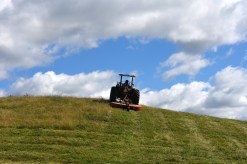Effective Strategies for Managing Water Erosion in Agricultural Landscapes

Water erosion is a common issue faced by farmers and landowners in agricultural landscapes. It occurs when rainfall or irrigation water flows over the land, carrying away valuable topsoil and nutrients. If left unmanaged, water erosion can lead to reduced soil fertility, decreased crop yields, and even land degradation. However, with the implementation of effective strategies, farmers can mitigate the effects of water erosion and protect their agricultural landscapes. In this article, we will explore some of these strategies in detail.
Implementing Conservation Tillage Practices
Conservation tillage practices are an effective way to manage water erosion in agricultural landscapes. Unlike conventional tillage methods that disturb the soil surface, conservation tillage involves minimal disturbance or even no-till practices. By leaving crop residues on the soil surface or using cover crops to protect it, conservation tillage helps to reduce runoff and improve soil structure.
Crop residues act as a natural barrier that intercepts rainfall and slows down its flow across the field. This allows more time for water infiltration into the soil, reducing runoff and minimizing erosion risk. Cover crops further enhance this effect by providing additional ground cover, protecting the soil from direct impact of raindrops.
Building Terraces and Contour Farming
Terraces and contour farming are physical measures that help manage water erosion by controlling the flow of runoff water across slopes. Terraces are level areas constructed along contours to create a series of steps on sloping fields. They help slow down runoff by creating small retention ponds where sediment can settle before water continues downhill.
Contour farming involves planting crops parallel to the contour lines of a hillside rather than straight up and down slopes. This practice helps break up long slope lengths into shorter segments which reduces both runoff velocity and erosion potential.
By implementing terraces and contour farming techniques, farmers can effectively manage water erosion on hilly or sloping agricultural landscapes, preventing soil loss and retaining valuable topsoil.
Installing Grassed Waterways
Grassed waterways are another effective strategy for managing water erosion in agricultural landscapes. They are designed channels with a gentle slope, covered with grass or other suitable vegetation. These channels help direct and slow down the flow of runoff water, reducing its erosive power.
The grassed cover on the waterway channels helps to absorb excess moisture and trap sediment carried by the runoff. This prevents soil particles from being washed away and allows them to settle within the channel. By promoting controlled drainage, grassed waterways effectively manage water erosion by preventing concentrated flows and reducing soil loss.
Implementing Buffer Strips
Buffer strips are areas of land planted with permanent vegetation, such as grasses or trees, located between cultivated fields and nearby water bodies, such as streams or rivers. These strips act as a natural filter that intercepts runoff from fields before it enters the water body.
Buffer strips help manage water erosion by slowing down runoff and allowing sediment to settle out before reaching the stream or river. They also provide additional benefits like nutrient uptake and habitat for wildlife.
By implementing buffer strips along field boundaries adjacent to water bodies, farmers can effectively reduce sediment and nutrient pollution in nearby water sources while also managing erosion in their agricultural landscapes.
In conclusion, managing water erosion is crucial for maintaining healthy agricultural landscapes. Implementing strategies such as conservation tillage practices, building terraces and contour farming, installing grassed waterways, and implementing buffer strips can greatly reduce soil loss due to erosion. By adopting these effective strategies, farmers can protect their valuable topsoil, maintain soil fertility, improve crop yields, and contribute to sustainable agriculture practices.
This text was generated using a large language model, and select text has been reviewed and moderated for purposes such as readability.





